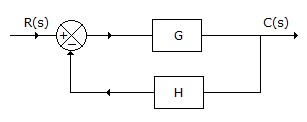Question

a.
1 : (1 + GH)
b.
1 : (1 + GH)¯¹
c.
1 : (1 - GH)
d.
1 : (1 - GH)¯¹
Posted under Electronics and Communication Engineering
Interact with the Community - Share Your Thoughts
Uncertain About the Answer? Seek Clarification Here.
Understand the Explanation? Include it Here.
Q. For the system in the given figure G varies slightly, the ratio of open loop sensitivity to closed loop sensitivity is
Similar Questions
Explore Relevant Multiple Choice Questions (MCQs)
Q. The loop transfer function of a feedback system is given below. The number of asymptotes of its root loci are
View solution
Q. Consider the following statements:
View solution
Q. For a closed loop system given below. The imaginary axis intercept of the root loci will be
View solution
Q. The polar plot of
View solution
Q. A FET is a __________ controlled device whereas a bipolar transistor is a __________ controlled device.
View solution
Q. In Bode diagram (log magnitude plot) the factor 1/jω in the transfer function gives a line having slope
View solution
Q. A negative feedback system has G(s) = 1/(s+1) and H(s) = K/s(s+2). The closed loop system is stable for
View solution
Q. Mechanical impedance is the ratio of
View solution
Q. Whether a linear system is stable or unstable that it
View solution
Q. A lag compensator is essentially a
View solution
Q. Stepper motors find applications in
View solution
Q. For type 2 system, the magnitude and phase angle of the term (jω)² in the denominator, at ω = 0, are respectively
View solution
Q. In an integral controller
View solution
Q. The phase margin and damping ratio have no relation.
View solution
Q. For the transport lag G(jω) = e^(-jωT), the magnitude is always equal to
View solution
Q. The log magnitude curve for a constant gain K is a
View solution
Q. If a system is to follow arbitrary inputs accurately the bandwidth should be
View solution
Q. Assertion (A): Potentiometers can not be used as error detectors in position control systems.
Reason (R): The resolution of a potentiometer places an upper limit on its accuracy
View solution
Q. Bellows converts
View solution
Q. Assertion (A): The steady state response, of a stable, linear, time invariant system, to sinusoidal input depends on initial conditions.
Reason (R): Frequency response, in steady state, is obtained by replacing s in the transfer function by jω
View solution
Recommended Subjects
Are you eager to expand your knowledge beyond Electronics and Communication Engineering? We've handpicked a range of related categories that you might find intriguing.
Click on the categories below to discover a wealth of MCQs and enrich your understanding of various subjects. Happy exploring!








